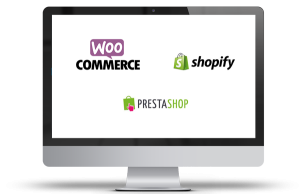Ecommerce website sales have shot through the roof in 2020 and many business owners are now looking for ways to get a piece of the online pie. The problem however is the massive learning curve you must undergo to learn to build a website, integrate an online store and then still learn to get traffic to your website. There are so many big words thrown around: “domain”, “hosting”, “payment gateway”, “AdWords”, “search engine optimization” and everything just feels like too much to take in. So, many business owners end up paying an expert to take it off their hands, but this can be costly.
In this blog article, we will explain the process step by step and teach you how to take your business online with very little effort and very little cost.
Step 1: Choose a website builder platform
There are many platforms that make it easy to build a website (Shopify, Wix, Weebly, and many more) but not many offer a shopping cart that integrates with South African payment gateways. That means you will end up building a beautiful website only to realise that you cannot get any SA card company to integrate their payment gateway on your website. There is literally no point in an online shop if customers cannot pay by card so be sure to check that out before you sign up/ start building your site.
Below is a list of the shopping carts we integrate with and our personal favourite is WooCommerce as it is built on WordPress (a platform used by 40% of websites Worldwide) and by far the most affordable and value-for-money solution available.
The best option is to go directly with building a WordPress site but WordPress could sometimes be a bit daunting to learn and time to set up, so many prefer to build on a platform like Wix because they take all the work out of it and make the process easy for the average person who does not have all the tech knowledge.

Step 2: Design your website pages using a template
Most website builder platforms have tons of pre-built themes to choose from – some are free and others you might pay once-off for. Once you have selected something that matches the way you want your website to look, you simply insert your content and images and if need be, change your colours to match your brand.
DESIGN TIP: To keep your website looking like a designer has built it, we suggest using the template as is and not making too many changes to it or moving too many things around. Try to position your content in the exact same way, no one likes to read anymore so be sure to make your headings effective in communicating the message across.
There are tons of websites that offer free images –www.pexels.com, www.canva.com, www.pixabay.com, www.PikWizard.com etc Simply google “free images” and a whole variety will come up.
If you need content for your website, go and have a look at some of your competitor’s websites and try searching for your products on Google. The websites that come up can teach you how to structure your content. Content is the basis for Search Engine optimisation (SEO) so be sure to focus all content on your search terms.
Step 3: Build your online shop
Your website builder should come with a pre-installed shopping cart system so you should be able to just start adding your products to it. Just imagine all of the times you have gone online to buy something and put yourself in your customer’s shoes. They cannot smell, taste, hear or touch your product so they will rely purely on their sense of sight. You need to explain the product to them and show them enough images of the product to help make the decision to buy.
- Add enough images
- Add your prices & specials
- Create your product titles (these can be unique names you have come up with or names that relate to what the product is)
- Add your product description, dimensions, variables & delivery fees
- Add your stock quantities. (If an item sells in your physical store, you will need to make sure that it goes out of stock on the online store and visa versa.)
Step 4: Register a domain
A domain name is your web address on the internet. It helps customers to find your website. We recommend choosing a domain name that is memorable, easy to type and not too lengthy.
- Your domain should ideally be similar to your business name since it is the basis for your online identity
- Your domain name should not include any funny characters or symbols. These make it difficult for people to type or spell it which could mean they end up somewhere else instead of your website.
- It should be easy to pronounce and spell
We recommend using www.123media.co.za domain checker to see what is available.
What is Hosting:
Hosting is a word used to describe the storage of files on a web server that allows the files to appear on the internet. Your website consists of many files eg media files (images), pages, and scripts and all these files need to be stored somewhere in order for visitors to access them via your domain.
If your website has been built on a shop/website builder platform like Shopify, etc, then you will not need to obtain hosting unless you plan to register email addresses with your domain or unless your website traffic grows to the point where you will need additional server resources and then you may be liable for a hosting fee.
Step 5: Make your website discoverable
Get your business listed on Google by indexing your pages and creating a Google Business account. The better your SEO on your pages is, the higher your chances are to drive organic traffic to your website.
Share your link with your customers:
- Add your website link to your Social Media pages
- If you have a database, email the good news to them
It is always beneficial to drive traffic to your website through Google Paid Ads. This is how you can reach new customers and drive sales to your website. If you have some marketing budget, you can put it into Google Ads or even Facebook Ads. You can hire an expert to set up your Google Ads but it’s always better if you can do it yourself to have more control over your site and ads, it is easier than you think!
Tips for great website content:
Reviews: Add some of your good customer reviews to your products or pages. Reviews are always good for any product/service. Ask people to review your business, brand, or service after they have received their goods.
Images: Use high-quality images with a clean, uncluttered background. If you take the photos yourself, just add a little lighting or do some photo edits to make sure the style of the images is the same.
Also, remember to add Alt text on each of your images to best describe the product and include your brand name in all of them where possible. Images in pages should also have alt text that corresponds with the keyword in your page title.
Font: Use a font that is easily readable and keep using the same font throughout your website.
Page content: Write search-worthy content, something with a how-to video or a blog post with relatable content. You can also use real-time trending subjects that apply to your product or service when writing blogs or find a content writer on Fiverr to help you. Blogs are a great way of getting traffic to your website.
Related articles: https://wappoint.co.za/grow-your-business-using-digital-marketing/

